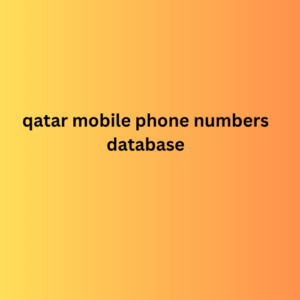Create a consistent and personalized
Posted: Sat Dec 07, 2024 6:02 am
For example, you can easily pick up on shared customer characteristics, like common shopping patterns. This is key for helping marketing teams target lookalike audiences and identify customer segments that they can create personalized marketing campaigns for.
Many CDPs, such as the Brevo CDP, already have recipes for qatar mobile phone numbers database segmenting audiences into the most important categories like purchase frequency and average order value.
Data can also be sent to business intelligence (BI) and analytics tools to help you report on specific metrics, measure operational efficiency, and do further analysis.
Benefits of using a customer data platform
Eliminate data silos. A customer data platform brings all of your customer information together in a single source of truth. No more trying to patch together scattered data from various software and documents.
Get higher-quality data. You decide what data you want to centralize. Your CDP platform makes sure each customer profile is unified and free from duplicate information. Data is also updated automatically between your CDP and connected input and output sources.
customer experience on all channels. Having customer data that is synced between all of your tools is key for creating a consistent omnichannel customer experience. Your messaging will be more relevant to your audience and sent at the right time, which will strengthen customer engagement.
Easy to use. CDPs easily integrate data sources and only need to be set up once. The Brevo CDP integrates seamlessly with the CRM, so your teams don’t need to rely on IT to get the data they need to succeed.
Protect customer privacy and data. A CDP helps your business with data governance (the correct handling of data). With all customer data in one place, managing privacy regulations and customer consent is simplified.
CDP vs DMP vs CRM
There’s a lot of software out there that uses customer data. Let’s clear up the differences briefly.
DMPs

Data management platforms also gather customer information but use data to make targeted ads to attract new customers. As such, customer profiles are for unknown people, rather than a known customer database.
The main source of input is typically third-party data but can also be other kinds of data. Data is also not stored indefinitely, which is a major drawback for companies looking to create long-term, established relationships.
CRM
Customer relationship management platforms also create customer profiles. CRMs use data for customer-facing tasks, like creating email marketing campaigns and building deal pipelines.
Many CDPs, such as the Brevo CDP, already have recipes for qatar mobile phone numbers database segmenting audiences into the most important categories like purchase frequency and average order value.
Data can also be sent to business intelligence (BI) and analytics tools to help you report on specific metrics, measure operational efficiency, and do further analysis.
Benefits of using a customer data platform
Eliminate data silos. A customer data platform brings all of your customer information together in a single source of truth. No more trying to patch together scattered data from various software and documents.
Get higher-quality data. You decide what data you want to centralize. Your CDP platform makes sure each customer profile is unified and free from duplicate information. Data is also updated automatically between your CDP and connected input and output sources.
customer experience on all channels. Having customer data that is synced between all of your tools is key for creating a consistent omnichannel customer experience. Your messaging will be more relevant to your audience and sent at the right time, which will strengthen customer engagement.
Easy to use. CDPs easily integrate data sources and only need to be set up once. The Brevo CDP integrates seamlessly with the CRM, so your teams don’t need to rely on IT to get the data they need to succeed.
Protect customer privacy and data. A CDP helps your business with data governance (the correct handling of data). With all customer data in one place, managing privacy regulations and customer consent is simplified.
CDP vs DMP vs CRM
There’s a lot of software out there that uses customer data. Let’s clear up the differences briefly.
DMPs

Data management platforms also gather customer information but use data to make targeted ads to attract new customers. As such, customer profiles are for unknown people, rather than a known customer database.
The main source of input is typically third-party data but can also be other kinds of data. Data is also not stored indefinitely, which is a major drawback for companies looking to create long-term, established relationships.
CRM
Customer relationship management platforms also create customer profiles. CRMs use data for customer-facing tasks, like creating email marketing campaigns and building deal pipelines.